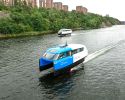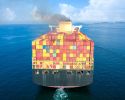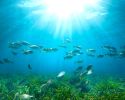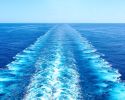Now HullMASTER can fix ship hulls across europe

A couple of years ago, researchers at Chalmers demonstrated that shipowners using silicone-based paints in the Baltic Sea save money and protect the environment. This is thanks to HullMASTER – a tool developed within the Swedish Transport Administration's industry program for Sustainable Shipping, managed by Lighthouse. Now, the tool has been adapted for use in more European waters, and interest in it is growing rapidly.
In the shipping industry, it’s no secret that a clean hull is crucial for both the economy and the environment. Even a moderate algal growth can increase fuel consumption by at least 10 percent – a figure that quickly becomes an expensive issue for shipping companies and also contributes to unnecessary emissions. Keeping the hull clean in a way that is both cost-effective and environmentally friendly is, however, far from simple.
For shipping companies, it’s not just about calculating the price of antifouling paints and how often dry-docking and underwater cleaning are needed. It’s also about weighing the environmental consequences of their choices. Traditional antifouling paints, which often contain toxic substances like copper and zinc, leach these chemicals directly into the sea, harming the marine environment. However, more environmentally friendly alternatives exist today – silicone-based foul release paints. These create a smooth surface that allows growth to shed at high speeds, but they are more expensive to apply and require careful cleaning when repainting.
But a ship’s emissions are, of course, not determined solely by what is painted on the hull. In addition to paint selection and maintenance, factors such as engine, fuel, exhaust cleaning, and even the route play a significant role. Furthermore, the intensity of hull fouling varies depending on where in the world the ship is located, and the discharge of toxic substances is influenced by both water temperature and salinity. However, there is a tool, HullMASTER (Hull Maintenance Strategies for Emission Reduction), that helps solve this complex equation. Two years ago, Erik Ytreberg, a researcher at Chalmers who led the HÅLL research project, shared what HullMASTER recommended for paint for traffic in the Baltic Sea.
“When we compare copper and silicone paints, we see that silicone paints not only offer environmental benefits – the cost is also generally lower over time for shipowners who use them. It’s a win-win situation,” he said at the time.
HullMASTER (Hull Maintenance Strategies for Emission Reduction) was initially developed for the Baltic Sea region, but in a follow-up project called HÅLL 2, the tool has been further developed for other European waters.
“We’ve painted plexiglass panels with different types of bottom paints and exposed them to water for up to a year, while photographing them every month – in the Swedish west coast, the North Sea, the Atlantic, the Mediterranean, and even the Black Sea. We have data from about ten large ports and can now tailor solutions for European shipping.”
Several of the major ports in Europe are located at river mouths with brackish water, sometimes almost freshwater, explains Erik Ytreberg. “There, fouling is less. If you only traffic between two or three such ports, you can easily optimize the solution with HullMASTER.”
As HullMASTER has developed, interest has increased. At conferences and events on antifouling, both paint companies, shipping companies, and authorities have participated and asked questions. “Classification societies have also become involved, and we’ve had follow-up meetings with them as they are interested in classifying bottom paints for sustainability. The Swedish Transport Agency has also shown great interest in HullMASTER and sees, in the long term, that it could be used as a basis in the IMO’s various subgroups,” says Erik Ytreberg.
The HÅLL projects and HullMASTER have also benefited the research community. “Initially, there were two senior researchers, a PhD student, and a post-doc involved in the project. Now we’re three senior researchers, three PhD students, and two post-docs. HullMASTER is something we can all gather around. It’s a tool we develop strategies for, have meetings about, and that ties together all our projects,” says Erik Ytreberg.
-
 NextWave – en podd som ska locka unga
NextWave – en podd som ska locka unga -
 Ny studie: Eldrivna pendelbåtar kan effektivisera Stockholms kollektivtrafik
Ny studie: Eldrivna pendelbåtar kan effektivisera Stockholms kollektivtrafik -
 Sjöfartens utsläpp ökar
Sjöfartens utsläpp ökar -
 Sociala relationer påverkar val av bränsle
Sociala relationer påverkar val av bränsle -
 Sjöfartens omställning kräver ”mjukare” påtryckningar
Sjöfartens omställning kräver ”mjukare” påtryckningar -
 Hon hade avtalad tid med Kapten ynkrygg
Hon hade avtalad tid med Kapten ynkrygg -
 Lighthouse omvärldsanalys 2025 – osäkerhet och tullar präglar sjöfarten
Lighthouse omvärldsanalys 2025 – osäkerhet och tullar präglar sjöfarten -
 Se seminariet Shipping in the Marine Environment
Se seminariet Shipping in the Marine Environment -
 Vad betyder egentligen de 90 procenten?
Vad betyder egentligen de 90 procenten? -
 Hålla där...
Hålla där...

